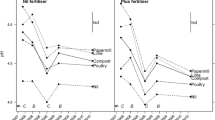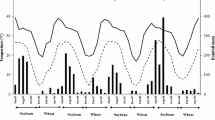Abstract
Background and aims
Long-term experiments could provide valuable information to determine the effects of an agronomic practice on agro-ecosystem productivity and stability. This study evaluated the long-term (18-year) impact of different tillage systems on faba bean (Vicia faba L.) productivity, including weed and broomrape incidence, and N2 fixation.
Methods
The experiment was carried out on a Vertisol under rainfed Mediterranean conditions. It was set up as a strip-plot design. The tillage systems were: conventional tillage (CT) with moldboard plow, reduced tillage (RT) with chisel plow, and no tillage (NT). Nitrogen fixation was estimated over 2 years in the final phase of the experiment using the 15N isotope dilution technique.
Results
On average, grain yield was 31 % and 23 % higher under NT than under CT and RT, respectively; however, the effect of tillage varied by year. The yield advantage of NT over CT was pronounced when rainfall was scarce. Average broomrape infestation was lower under NT than under CT, but a reduction in tillage intensity resulted in an increase in weed biomass. Tillage had no effect on weed richness, but the use of the NT technique progressively altered the weed composition by determining conditions conducive to the growth of a few weed species that are hard to control. Nitrogen fixation was strongly influenced by tillage, being higher under NT than under CT.
Conclusions
The results suggest that NT is a valuable option in the rainfed cereal–legume rotation systems of Mediterranean environments; however, the success of NT technique depends on the use of effective weed control strategies.
Similar content being viewed by others
References
Bakker JP, Poschlod P, Strykstra RJ, Bekker RM, Thompson K (1996) Seed banks and seed dispersal: important topics in restoration ecology. Acta Bot Neerl 45:461–490
Barberi P, Lo Cascio B (2000) Long-term tillage and crop rotation effects on weed seedbank size and composition. Weed Res 41:325–340
Bescansa P, Imaz MJ, Virto I, Enrique A, Hoogmoed WB (2006) Soil water retention as affected by tillage and residue management in semiarid Spain. Soil Tillage Res 87:19–27
Bilalis D, Efthimiadis P, Sidras N (2001) Effect of three tillage systems on weed flora in a 3-yr rotation with four crop. J Agron Crop Sci 186:135–141
Blackshaw RE (2005) Tillage intensity affects weed communities in agroecosystems. In: Inderjit S (ed) Invasive plants: ecological and agricultural aspects. Birkhauser Verlag, Basel, pp 209–221
Blackshaw RE, Larney FJ, Lindwall CW, Watson PR, Derksen DA (2001) Tillage intensity and crop rotation affect weed community dynamics in a winter wheat cropping system. Can J Plant Sci 81:805–813
Cardina J, Regnier E, Harrison K (1991) Long-term tillage effects on seed banks in three Ohio soils. Weed Sci 39:186–194
Casa R, Lo Cascio B (2008) Soil conservation tillage effects on yield and water use efficiency on irrigated crops in central Italy. J Agron Crop Sci 194:310–319
Chancellor RJ (1985) Changes in the weed flora of an arable field cultivated for 20 years. J Appl Ecol 22:491–501
Chhokar RS, Sharma RK, Jat GR, Pundir AK, Gathala MK (2007) Effect of tillage and herbicides on weeds and productivity of wheat under rice–wheat growing system. Crop Prot 26:1689–1696
Derksen DA, Lafond GP, Thomas AG, Loeppky HA, Swanton CJ (1993) Impact of agronomic practices on weed communities: tillage systems. Weed Sci 41:409–417
Dorado J, López-Fando C (2006) The effect of tillage system and use of a paraplow on weed flora in a semiarid soil from central Spain. Weed Res 46:424–431
Dorado J, Del Monte JP, López-Fando C (1999) Weed seedbank response to crop rotation and tillage in semiarid agroecosystems. Weed Sci 47:67–73
FAO AQUASTAT (2011) http://www.fao.org/nr/water/aquastat/date/query/results.html, Database Query, FAO of the UN, commissioned for the exclusive use of FAO—Conservation Agriculture
Fried M, Middleboe V (1977) Measurements of amount of nitrogen fixed by a legume crop. Plant Soil 47:713–715
Grenz JH, Manschadi AM, DeVoil P, Meinke H, Sauerborn J (2005) Assessing strategies for Orobanche sp. control using a combined seedbank and competition model. Agron J 97:1551–1559
Guzha AC (2004) Effects of tillage on soil microrelief, surface depression storage and soil water storage. Soil Tillage Res 76:105–114
Hughes RM, Herridge DF (1989) Effect of tillage on yield, nodulation and nitrogen fixation of soybean in far north-coastal New South Wales. Aust J Exp Agric 29:671–677
Jensen ES, Hauggaard-Nielsen H (2003) How can increase use of biological N2 fixation in agriculture benefit the environment? Plant Soil 252:176–186
Jordan VW, Leake AR, Ogilvy SE (2000) Agronomic and environmental implications of soil management practices in integrated farming systems. Aspects Appl Biol 62:61–66
Kent M, Coker P (1994) Vegetation description and analysis—a practical approach. Wiley, Chichester, p 363
Kirkegaard JA (1995) A review of trends in wheat yield responses to conservation cropping in Australia. Aust J Exp Agric 35:835–848
Kladivko EJ (2001) Tillage systems and soil ecology. Soil Tillage Res 61:61–76
Lal R (2007) Constraints to adopting no-till farming in developing countries. Soil Tillage Res 94:1–3
Lampurlanés J, Angás P, Cantero-Martínez C (2002) Tillage effects on water storage during fallow, and on barley root growth and yield in two contrasting soils of the semi-arid Segarra region in Spain. Soil Tillage Res 65:207–220
López-Bellido RJ, López-Bellido L, López-Bellido FJ, Castillo JE (2003) Faba bean (Vicia faba L.) response to tillage and soil residual nitrogen in a continuous rotation with wheat (Triticum aestivum L.) under rainfed Mediterranean conditions. Agron J 95:1253–1261
López-Bellido RJ, Benitez-Vega J, López-Bellido L (2009) No-tillage improves broomrape control with glyphosate in faba-bean. Agron J 101:1394–1399
Lyon DJ, Stroup WW, Brown RE (1998) Crop production and soil water storage in long-term winter wheat-fallow tillage experiments. Soil Tillage Res 49:19–27
Madari B, Machado PLOA, Torres E, de Andrade AG, Valencia LIO (2005) No tillage and crop rotation effects on soil aggregation and organic carbon in a Rhodic Ferralsol from southern Brazil. Soil Tillage Res 80:185–200
Magurran AE (1988) Diversity indices and species abundance models. In: Ecological diversity and its measurements. Princeton University Press, Princeton, NJ (USA), pp 7–46
Matus A, Derksen DA, Walley FL, Loeppky HA, van Kessel C (1997) The influence of tillage and crop rotation on nitrose fixation in lentil and pea. Can J Plant Sci 77:197–200
Mazzoncini M, Di Bene C, Coli A, Antichi D, Petri M, Bonari E (2008) Rainfed wheat and soybean productivity in a long-term tillage experiment in central Italy. Agron J 100:1418–1429
McCloskey M, Firbank LG, Watkinson AR, Webb DJ (1996) The dynamics of experimental arable weed communities under different management practices. J Veg Sci 7:779–808
McIntosh MS (1983) Analysis of combined experiments. Agron J 75:153–155
Moonen AC, Barberi P (2004) Size and composition of the weed seedbank after 7 years of different cover-crop maize management systems. Weed Res 44:163–177
Murphy SD, Clements DR, Belaoussoff S, Kevan PG, Swanton CJ (2006) Promotion of weed species diversity and reduction of weed seedbanks with conservation tillage and crop rotation. Weed Sci 54:69–77
Musselman LJ (1980) The biology of Striga, Orobanche, and other root-parasitic weeds. Annu Rev Phytopathol 18:463–489
Ordoñez Fernandez R, Gonzalez Fernandez P, Giraldez Cervera JV, Perea Torres F (2007) Soil properties and crop yields after 21 years of direct drilling trials in southern Spain. Soil Tillage Res 94:47–54
Plaza EH, Kozak M, Navarrete L, Gonzalez-Andujar JL (2011) Tillage system did not affect weed diversity in a 23-yr experiment in Mediterranean dryland. Agric Ecosyst Environ 140:102–105
Radford BJ, Key AJ, Robertson LN, Thomas GA (1995) Conservation tillage increases in soil water storage, soil animal populations, grain yield, and response to fertiliser in the semi-arid subtropics. Aust J Exp Agric 35:223–232
Reiter K, Schmidtke K, Rauber R (2002) The influence of long-term tillage systems on symbiotic N2 fixation of pea (Pisum sativum L.) and red clover (Trifolium pratense L.). Plant Soil 238:41–55
Roberts HA (1986) Seed persistence in soil and seasonal emergence in plant species from different habitats. J Appl Ecol 23:639–656
SAS Institute (2008) SAS/STAT 9.2 user’s guide. SAS Inst., Cary
Sosnoskie LM, Herms CP, Cardina J (2006) Weed seedbank community composition in a 35-yr-old tillage and rotation experiment. Weed Sci 54:263–273
Souza A, Colozzi-Filho A, Giller KE (2003) The soil microbial community and soil tillage. In: El Titi A (ed) Soil tillage in agroecosystems. CRC Press, London, pp 51–81
Spandl E, Durgan BR, Forcella F (1999) Foxtail (Setaria spp.) seedling dynamics in spring wheat (Triticum aestivum) are influenced by seeding date and tillage regime. Weed Sci 47:156–160
Stubbs TL, Kennedy AC, Schillinger WF (2004) Soil ecosystem change during the transition to no-till cropping. J Crop Improv 11:105–135
Swanton CJ, Shrestha A, Roy CR, Ball-Coelho BR, Knezevic SZ (1999) Effect of tillage systems, N, and cover crop on the composition of weed flora. Weed Sci 47:454–461
Taylor IN, Walker SR, Adkins SW (2005) Burial depth and cultivation influence emergence and persistence of Phalaris paradoxa seed in an Australian sub-tropical environment. Weed Res 45:33–40
Unkovich M, Herridge D, Peoples M, Cadisch G, Boddey R, Giller K, Alves B, Chalk P (2008) Measuring plant-associated nitrogen fixation in agricultural systems. ACIAR Monograph No. 136:pp 258
Van der Maarel E (1979) Transformation of cover-abundance values in phytosociology and its effects on community similarity. Vegetatio 39:97–114
West TO, Post WM (2002) Soil organic carbon sequestration rates by tillage and crop rotation: a global data analysis. Soil Sci Soc Am J 66:1930–1946
Wheatley DM, Macleod DA, Jessop RS (1995) Influence of tillage treatments on N2 fixation of soybean. Soil Biol Biochem 27:571–574
Wilsey B, Stirling G (2007) Species richness and evenness respond in a different manner to propagule density in developing prairie microcosm communities. Plant Ecol 190:259–273
Young FL, Thorne ME (2004) Weed-species dynamics and management in no-till and reduced-till fallow cropping systems for the semi-arid agricultural region of the Pacific Northwest, USA. Crop Prot 23:1097–1110
Zanin G, Otto S, Riello L, Borin M (1997) Ecological interpretation of weed dynamics under different tillage systems. Agric Ecosyst Environ 66:177–188
Acknowledgments
This study was funded by: MiRAAF (project ‘Sperimentazione per il miglioramento del grano duro in Sicilia’); MiPA-UE (project POM A16 Misura 2); Regione Sicilia (Patti territoriali Magazzolo-Platani and project SICOBIO); MiPAF (project SICOBIOS).
Author information
Authors and Affiliations
Corresponding author
Additional information
Responsible Editor: Euan K. James.
Rights and permissions
About this article
Cite this article
Giambalvo, D., Ruisi, P., Saia, S. et al. Faba bean grain yield, N2 fixation, and weed infestation in a long-term tillage experiment under rainfed Mediterranean conditions. Plant Soil 360, 215–227 (2012). https://doi.org/10.1007/s11104-012-1224-5
Received:
Accepted:
Published:
Issue Date:
DOI: https://doi.org/10.1007/s11104-012-1224-5




